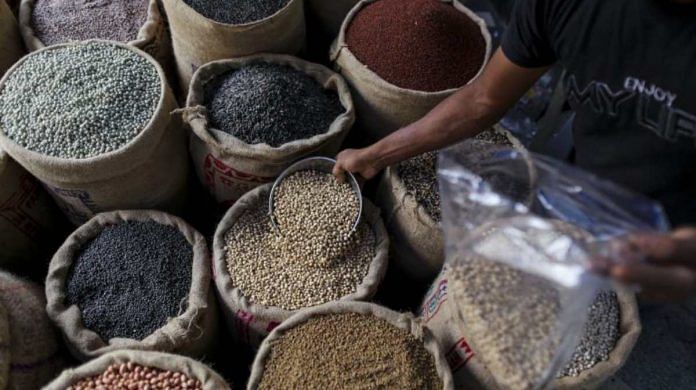New Delhi: The Narendra Modi government is likely to procure more pulses this year to boost the central buffer stock of pulses to 23 lakh metric tonnes (LMT) in 2021-22 from 20 LMT last year — an increase of 15 per cent. The move is expected to guard against inflation and also help support farmers.
According to documents accessed by ThePrint, the Price Stabilisation Fund Management Committee — under the aegis of the Ministry of Consumer Affairs — in a meeting last week strongly recommended an increase in the buffer stock of pulses from last year on account of continued inflation in the market prices of pulses coupled with increasing year-on-year production.
“Despite a bumper kharif harvest, the prices of pulses have continued to increase,” said a senior official from the Department of Consumer Affairs, who was present at the meeting.
“The price of tur/arhar, a kharif crop, is already hovering above the MSP (minimum support price) in the retail as well as in the wholesale markets. Due to this, NAFED (National Agricultural Cooperative Marketing Federation of India) has not been able to procure enough arhar dal for the buffer stock too,” added the official, who didn’t want to be named.
“An increase in buffer stock of pulses will also provide price support to farmers in peak harvest season if a regional price crash occurred.”
“This will also enable the government to intervene in the market by releasing a buffer stock of pulses to safeguard consumers from extreme volatilities in the market as it happened in 2015 or to provide pulses to people if any natural calamity or situation such as last year’s lockdown occurs,” added the official.
Also read: Modi govt promised free pulses to 20 crore, only 18% have got them so far
Rising prices of pulses
Chana dal accounts for 45-50 per cent of the total production of pulses in India — between the rabi and kharif seasons, its production is around 112.3 LMT per year, out of the overall figure of 230 LMT. Tur dal, with 42.5 LMT, accounts for 16 per cent. Together, these two pulses comprise up to three-fourth of India’s consumption.
According to data available with the Department of Consumer Affairs, the maximum retail price of gram/chana dal was Rs 94 on 1 February, which increased to Rs 129 on 1 March. The minimum retail prices of chana dal have also gone up to Rs 59/kg from Rs 55/kg in the same period.
Even the wholesale arhar prices are currently hovering between Rs 6,000 and Rs 7,550/quintal in major markets of Maharashtra and Karnataka.
This inflation is despite arhar being a kharif crop, which has just seen the end of its harvest season. But its price is still much above the MSP of Rs 6,000/quintal.
Estimates of pulse production
According to the agriculture ministry’s second advance estimate of crop production for 2020-21, total pulses production is estimated at 24.42 million tonnes, which is higher by 1.40 million tonnes than the last year’s production of 23.03 million tonnes.
However, tur/arhar production is estimated to be 3.88 million tonnes, a slight decline from the 2019-20 final production of 3.89 million tonnes. But according to sources in the pulses milling industry, the actual production could come down in the range of 3.3 million tonnes to 3.5 million tonnes.
The retail arhar prices are currently in the Rs 95-110/kg range in many states and the prices are likely to go up further.
The government procures majority of the pulses for buffer stock through its nodal agency NAFED under the Price Stabilisation Fund.
Under this fund, the Centre’s nodal agencies procure crops at the minimum support price to counter both falling prices in domestic markets as well as a sudden surge in commodity prices by releasing the buffer stock in physical markets when prices rise sharply.
Besides NAFED, the Food Corporation of India (FCI) and Small Farmers’ Agribusiness Consortium (SFAC) also buy pulses to ensure farmers get the minimum support price for their produce.
Though India is the world’s leading producer and consumer of pulses, the annual production of pulses in the country somehow remains short of the demand of around 26 million tonnes.
Also read: Pulse of the problem — rising output plus rising imports have messed up India’s dal prices



